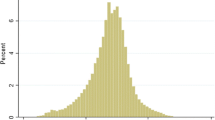Abstract
The use of mental health indicators to compare provider performance requires that comparisons be fair. Fair provider comparisons mean that scores are risk adjusted for client characteristics that influence scores and that are beyond provider control. Data for the study are collected from 336 outpatients receiving publicly funded mental health services in Washington State. The study compares alternative specifications of multiple regression-based risk-adjustment models to argue that the particular form of the model will lead to different conclusions about comparative treatment agency performance. In order to evaluate performance fairly it is necessary to not only incorporate risk adjustment, but also identify the most correct form that the risk-adjustment model should take. Future research is needed to specify, test, and validate the mental health risk-adjustment models best suited to particular treatment populations and performance indicators.
Similar content being viewed by others
References
Iezzoni LI. The risks of risk-adjustment.Journal of the American Medical Association. 1997;278:1600–1607.
Ellis RP, Ash A. Refinements to the use of diagnostic cost group (DCG) models.Inquiry. 1995–96;32:418–429.
Newhouse JP, Beeuwkes M, Chapman JD.Risk Adjustment and Medicare. New York: The Commonwealth Fund; 1997.
Zimmerman JE, Wagner DP, Draper EA, et al. Evaluation of acute physiology and chronic health evaluation III predictors of hospital mortality in an independent database.Critical Care Medicine. 1998;26:1317–1326.
Ettner SL, Frank RG, McGuire TG, et al. Risk adjustment of mental health and substance abuse payments.Inquiry. 1998;35:223–229.
Newman FL, DeLiberty RN, Ward EO. Hoosier Assurance Plan IV: consumer progress/outcomes by risk adjustment group for those enrolled for more than 3 years. Presented at the 6th Annual Florida Conference on Behavioral Healthcare Evaluation; December 9, 1999; Orlando, FL.
Pandiani JA, Banks SM, Schacht LM. Using incarceration rates to measure mental health program performance.The Journal of Behavioral Health Services & Research. 1999;25:300–311.
Fischer EP, Cuffel BJ, Owen RR.Schizophrenia Outcomes Module User's Manual. Little Rock, AR: Center for Outcomes Research and Effectiveness; 1997.
Smith GR, Burnam A, Burns B, et al.Major Depression Outcomes Module User's Manual. Little Rock, AR: Center for Outcomes Research and Effectiveness; 1998.
Bickman L.Advances in Program Theory. New Directions for Program Evaluation No. 47. San Francisco: Jossey-Bass; 1990.
Bogaert-Martinez E, Caen E, Wilson W, et al. The SF-36 as a measure of functioning and health related quality of life in individuals with severe and persistent mental illness: psychometric properties and normative data. Presented at the Sixth Annual National Conference on State Mental Health Agency Services Research and Program Evaluation; February 13, 1996; Alexandria, VA.
McHorney C, Ware J, Raczek A. The MOS 36-item SF-36. II: psychometric and clinical tests of validity in measuring physical and mental health constructs.Medical Care. 1993;31:247–263.
McGee J, Goldfield N, Riley K, et al.Collecting Information from Health Care Consumers: A Resource Manual of Tested Questionnaires and Practical Advice. Gaithersburg, MD: Aspen Publishers, Inc; 1996.
Comtois KD, Ries R, Armstrong HE. Case manager ratings of the clinical status of dually diagnosed outpatients.Hospital and Community Psychiatry. 1994;45:568–573.
Lehman A.Quality of Life Interview: Core Version. College Park, MD: University of Maryland, Center for Mental Health Services Research; 1991.
Hendryx M, Dyck D, Srebnik D. Risk-adjusted outcome models for public mental health outpatient programs.Health Services Research. 1999;34:171–195.
Srebnik D, Hendryx MS, Stevenson J, et al. Development of outcome indicators for monitoring the quality of public mental health care.Psychiatric Services. 1997;48:903–909.
Schwartz M, Ash AS. Evaluating the performance of risk adjustment methods: continuous measures. In: Iezzoni LI, ed.Risk Adjustment for Measuring Health Care Outcomes. Ann Arbor, MI: Health Administration Press; 1994:287–311.
Gruenberg L, Kaganova E, Hornbrook MC. Improving the AAPCC with health-status measures from the MCBS.Health Care Financing Review. 1996;17(3):59–75.
Center for Mental Health Services.Methodological Standards for Outcome Measures. Washington, DC: Substance Abuse and Mental Health Services Administration; 1997.
Author information
Authors and Affiliations
Corresponding author
Rights and permissions
About this article
Cite this article
Hendryx, M.S., Teague, G.B. Comparing alternative risk-adjustment models. The Journal of Behavioral Health Services & Research 28, 247–257 (2001). https://doi.org/10.1007/BF02287242
Issue Date:
DOI: https://doi.org/10.1007/BF02287242




